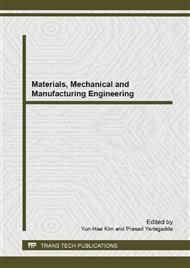p.297
p.302
p.307
p.311
p.316
p.322
p.326
p.332
p.337
Ceramic Powder (Silicon Carbide) - Monitoring and Influencing Process its Production
Abstract:
The paper describes research into the production of ceramic powder. Ceramic powder or ceramic granulate is the product that arises in spray drying emulsion. In our case was investigated granules - Silicon carbide (SiC). Silicon carbide is one of the most used materials in engineering technology. The essence of the research was to create a mathematical model of the drying process and identify the parameters influencing drying. Mathematical model was used to create balance equations, from which it was expressed parameter - mensural granulate moisture u2. Endpoint was the absolute humidity of dry gas to exit the furnace Y2. Based on the measured and calculated values was created graph absolute humidity drying gas furnace outputs for mensural material moisture output furnace.
Info:
Periodical:
Pages:
316-321
Citation:
Online since:
November 2013
Authors:
Keywords:
Price:
Сopyright:
© 2014 Trans Tech Publications Ltd. All Rights Reserved
Share:
Citation:


